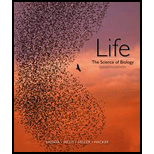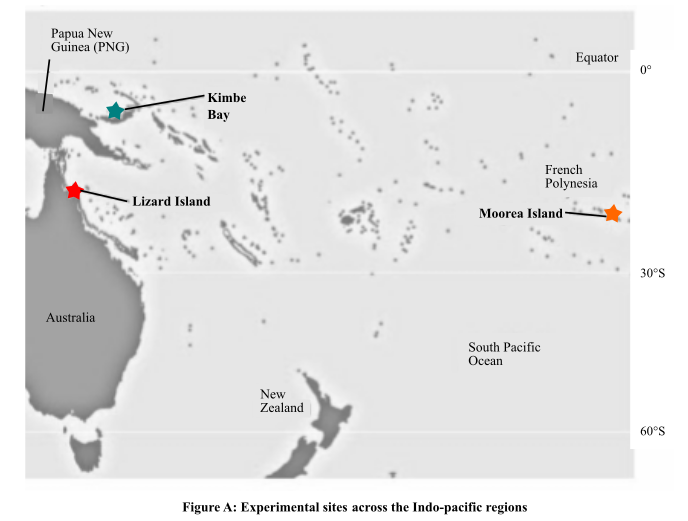
To review:
The outcome of results of the experiment on relationships between the number of fish species and the species diversity of the corals in their respective habitats. Also, explain the way in which this knowledge would help in maintaining the coral reef ecosystem under threat.
Given:
Figure 1 shows the study area of the experiment in the Indo-pacific region with high coral reef species. The three sites are Kimbe Bay in Papua New Guinea (PNG), Moorea Island in French Polynesia, and Lizard Island in the Great Barrier Reef on the east coast of Australia.

Figure 1: Experimental sites across the Indo-pacific region.
Graph 1 shows the results of the number of the fish species found in the coral species region. A relationship was established between the index of sensitivity and the number of coral species.

Graph 1: Relationship between the index of sensitivity and number of coral species.
Introduction:
An experiment was conducted in the three islands, Kimbe Bay (highest fish diversity), Moorea island (lowest number of fish species), and Lizard island (with an intermediate number of fish species). In the experiment, the coral diversity was manipulated and associated fish species were counted during a 12-month period. Based on this experiment, an index of sensitivity was calculated to evaluate the relationship among the number of coral species and the number of associated fish species that inhabited in the plots.
Explanation of Solution
Corals are coelenterate, which is composed of thin layers of calcium carbonate that is secreted over time by coral polyps. Polyps witness a symbiotic relationship with zooxanthellae. Coral reef ecosystem is the most diverse ecosystem on the earth. It is made up of corals, sponges, molluscs, Fish, sea turtles, dolphins, sharks, and many other aquatic organisms. Corals and fishes have a symbiotic relationship where many fishes depend on corals for their food and habitat whereas the corals depend on grazing by certain fishes for reproduction.
The results suggest that fishes at the Kimbe Bay Island were more sensitive to changes in the number of coral species and they were expected to undergo local extinctions. This happens because the fish species diversity is more in this region. On the other hand, Moorea island, which inhabited fewer number fishes, were not much sensitive to changes in the number of coral species.
These results might be useful in preserving the coral reefs, which inhabit a large number of fish species. As the fishes and simultaneously the coral reefs in the Kimbe Bay are sensitive to any changes, they might face extinction threats from the activities of the nearby human population. Thus, the ecologists must give special attention to this region (Kimbe Bay) while laying down protective guidelines for the coral reefs all across the globe.
Therefore, it can be concluded that decline in the number of fish diversity is directly proportional to the decrease in the coral species. This can help the marine biologists to pay special attention to the sensitive regions of coral diversity.
Want to see more full solutions like this?
Chapter 53 Solutions
Life: The Science of Biology
- Explain how the hormones of the glands listed below travel around the body to target organs and tissues : Pituitary gland Hypothalamus Thyroid Parathyroid Adrenal Pineal Pancreas(islets of langerhans) Gonads (testes and ovaries) Placentaarrow_forwardWhat are the functions of the hormones produced in the glands listed below: Pituitary gland Hypothalamus Thyroid Parathyroid Adrenal Pineal Pancreas(islets of langerhans) Gonads (testes and ovaries) Placentaarrow_forwardDescribe the hormones produced in the glands listed below: Pituitary gland Hypothalamus Thyroid Parathyroid Adrenal Pineal Pancreas(islets of langerhans) Gonads (testes and ovaries) Placentaarrow_forward
- Please help me calculate drug dosage from the following information: Patient weight: 35 pounds, so 15.9 kilograms (got this by dividing 35 pounds by 2.2 kilograms) Drug dose: 0.05mg/kg Drug concentration: 2mg/mLarrow_forwardA 25-year-old woman presents to the emergency department with a 2-day history of fever, chills, severe headache, and confusion. She recently returned from a trip to sub-Saharan Africa, where she did not take malaria prophylaxis. On examination, she is febrile (39.8°C/103.6°F) and hypotensive. Laboratory studies reveal hemoglobin of 8.0 g/dL, platelet count of 50,000/μL, and evidence of hemoglobinuria. A peripheral blood smear shows ring forms and banana-shaped gametocytes. Which of the following Plasmodium species is most likely responsible for her severe symptoms? A. Plasmodium vivax B. Plasmodium ovale C. Plasmodium malariae D. Plasmodium falciparumarrow_forwardStandard Concentration (caffeine) mg/L Absorbance Reading 10 0.322 20 0.697 40 1.535 60 2.520 80 3.100arrow_forward
- please draw in the answers, thank youarrow_forwarda. On this first grid, assume that the DNA and RNA templates are read left to right. DNA DNA mRNA codon tRNA anticodon polypeptide _strand strand C с A T G A U G C A TRP b. Now do this AGAIN assuming that the DNA and RNA templates are read right to left. DNA DNA strand strand C mRNA codon tRNA anticodon polypeptide 0 A T G A U G с A TRParrow_forwardplease answer all question below with the following answer choice, thank you!arrow_forward
 Biology Today and Tomorrow without Physiology (Mi...BiologyISBN:9781305117396Author:Cecie Starr, Christine Evers, Lisa StarrPublisher:Cengage Learning
Biology Today and Tomorrow without Physiology (Mi...BiologyISBN:9781305117396Author:Cecie Starr, Christine Evers, Lisa StarrPublisher:Cengage Learning Biology (MindTap Course List)BiologyISBN:9781337392938Author:Eldra Solomon, Charles Martin, Diana W. Martin, Linda R. BergPublisher:Cengage Learning
Biology (MindTap Course List)BiologyISBN:9781337392938Author:Eldra Solomon, Charles Martin, Diana W. Martin, Linda R. BergPublisher:Cengage Learning
 Biology: The Unity and Diversity of Life (MindTap...BiologyISBN:9781305073951Author:Cecie Starr, Ralph Taggart, Christine Evers, Lisa StarrPublisher:Cengage Learning
Biology: The Unity and Diversity of Life (MindTap...BiologyISBN:9781305073951Author:Cecie Starr, Ralph Taggart, Christine Evers, Lisa StarrPublisher:Cengage Learning Biology: The Dynamic Science (MindTap Course List)BiologyISBN:9781305389892Author:Peter J. Russell, Paul E. Hertz, Beverly McMillanPublisher:Cengage Learning
Biology: The Dynamic Science (MindTap Course List)BiologyISBN:9781305389892Author:Peter J. Russell, Paul E. Hertz, Beverly McMillanPublisher:Cengage Learning





